Weight Reduction - How I put my 340R on a diet
by Peter Crook
Introduction
Any car will be the subject of numerous design compromises during it's development, often these result from the conflict of interests between 'the designers' and 'the engineers'.
Often restrictions in budget mean that compromises have to be made and desirable developments shelved because of lack of time or the need to meet projected costs.
In this respect the 340R is no different to any other car, and having lived with the car for a couple of years it became apparent to me that in my opinion certain areas of the design could be improved.
A common criticism of the 340R when it was launched was the fact that the production cars did not live up to the much hyped '340bhp/tonne' power to weight ratio.
This failing seemed to come not from a lack of engine power as around 195 bhp was the anticipated output from Rover's revised 190 VHPD engine which had already been fitted in similar but less powerful form to the 190 Sport Elise, and had now been revised by Power Train Projects. Instead the failing came from a higher than anticipated weight of the finished car.
So why was the car heavier than the designers and engineers intended it to be ?
The main reasons are :
-
Additional items required to be fitted to the car to comply with construction and safety legislation
-
Styling emphasis over weight reduction.
-
Lack of budget for implementation of weight reduction measures
Disclaimer
The reader should be aware that my comments with regards to non essential items and modifications only relate to the use of the vehicle as a track day only vehicle in the UK. Removal of parts or substitution of parts may make the vehicle illegal for on road use. Different legislative requirements throughout the world apply. As always, any readers contemplating any alterations to their vehicle should satisfy themselves as to any legal or safety implications that their changes could have.
Areas for improvement
A close examination of the car reveals several areas where improvements could be made.
Removal of non essential parts
Pretty obvious this but, the list of potential parts for removal includes :
rear miniature windscreen, air inlet drive by noise restrictor valve, catalytic converter, second air inlet filter, charcoal fuel tank re breather canister, mid spoiler pedestrian hoops, mid spoiler assembly, fog light, reversing light, passenger foot rest etc.....
Replacement of excessively heavy stylised parts
The two items which appear to be excessively heavy related to their function are the roll over hoop and the rear wing supports.
Fitment of higher specification reduced weight parts
The list of potential parts includes :
carbon fibre mudguards, carbon fibre seats, titanium silencer, alloy fuel tank, race battery, carbon fibre engine lid, carbon fibre steering wheel, lightweight alternator and lightweight brake discs.
I decided to apply all of the above modifications to my own car to see what the effect would be.
My target - to reduce the kerb weight of the standard car by 80kg
Kerb weight/Dry weight/Power to weight
Mention must be made of some of the technical issues surrounding the above terms, especially in the context which they have been used by the motoring press and Lotus Cars.
Original press hype in July 1998 stated that the car had 'prospective power to weight ratio of '340 BHP per ton'.
By the time the vehicle was entering production this specification had changed (in the words of Lotus's own information handout to owners) to '340PS per tonne dry power to weight ratio with track pack options'
Because PS (or metric horsepower) is less than the british Brake Horse Power, and the power to weight ratio was 'dry' (ie measured with the car without any fluids and thus lighter than in a roadworthy state) this meant that many owners felt that they had been mislead by the previous publicity which most people had taken to mean the car would have a power to weight ratio of 340BHP/ton at it's kerb weight and without further modifications.
Kerb weight is defined as the weight of the car with all fluids (eg coolant, oil, brake fluid) and with a full tank of fuel but no passengers or luggage.
The official Lotus published figures for the standard car are :
Kerb Weight 701kg
Dry Weight 661kg
The following are detailed notes on my weight saving measures :
Non essential parts
Rear Miniature windscreen
A small triangle of glass behind the roll over hoop, this was fitted by Lotus to comply with EU regulations relating to the distance between the high level stop lamp and the rear windscreen. Completely useless, liable to break and weighs 0.37kg.
Air inlet drive by restrictor
The
air intake hose is fitted within the engine bay pointing down over the
exhaust manifold, and in turn is fitted to a large resonance valve.
This device is controlled by the engine management system and is
switched on and off during Type Approval drive by tests which take place in
2nd or 3rd gear. When the valve is operated the engine performance is reduced along with
the noise
The valve and air inlet routing is required solely to pass type approval noise tests and is counter productive to normal operation of the engine. It weighs 0.7kg.
Fuel tank breather charcoal canister and plumbing
Normally removed as part of the 190 upgrade, this is fitted to comply with fuel vapour emissions regulations for new mass produced cars. Weighs 0.7kg.
Mid spoiler pedestrian hoops
Two small metal hoops fitted to comply with legislation regarding reversing into pedestrians. Not considered essential for track use, they weigh 0.15kg a pair.
Passenger foot rest
Secured with velcro. An easy way of removing 0.55kg from the car.
Mid spoiler assembly
Possibly too radical for some. The removal of the mid spolier assembly (which is purely cosmetic) with its fog light and reversing light, saves 5.6kg. The car looks pretty bare and ugly at the rear without it.
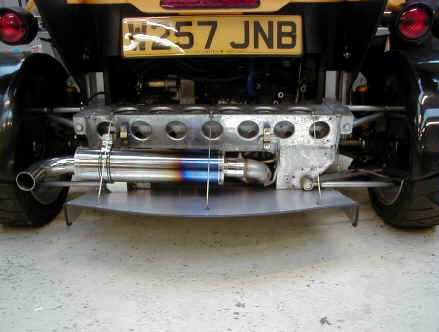
rear view with mid spoiler removed, miniature Ti exhaust and Elise diffuser
Miniature titanium silencer
First seen on Tony Shute's special 'Expose' hill climbing machine, his idea of using a modified superbike silencer made me think that this would be the one of lightest possible silencers available.
Essentially a 450mm long Titanium cased superbike can with a 90 degree tailpipe, this couples to a modified 340R flexi joint (flange chopped off and with a pipe extension). A large Mikalor jubilee clip secures the two.
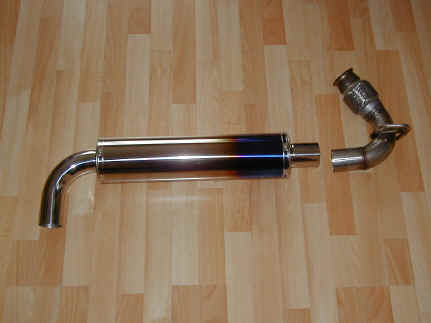
The silencer was made by Blue Flame Performance, who also manufactured the Lotus Titanium sports exhaust.
The silencer weighs 2.2kg and replaces the combined weight of silencer and catalytic converter on the standard car of 16kg.
The silencer has a rather pleasant deep bass note on tick over and has been measured at 101dbA at 5100 rpm.
The tailpipe has no lip in order to facilitate the easy fitment of a Supertrap (or similar) clamp on silencer should this be necessary for track days with more stringent noise regulations.
Elise diffuser
Removal of the standard 340R mid spoiler means that there are no longer any supports left to secure the standard 340R diffuser.
A solution already engineered by Lotus on their lightweight track car was to utilise a standard Elise S1 rear diffuser together with three stainless steel stays which bolt to the rear chassis cross member. The Elise diffuser has the added advantage of being longer (and therefore more aerodynamically effective) and it is also 0.57kg lighter than the 340R diffuser.
Lotus part numbers for these are :
Elise diffuser : B111A0215F
Track pack outer stay (2 off required) : A340A0044
Track pack centre stay (1 off required) :A340A0045
Custom built roll over hoop
The standard 340R roll over hoop is a massively engineered affair constructed from specially manufactured extra thick wall ovalised steel tubing.
My understanding is that this item was subject to heated debate between the designers who felt it was essential to the style of the car , and the engineers who felt it was excessively heavy and expensive. In the end the designers won, and the result is something which looks sweet but is far stronger end heavier than it needs to be. When I removed the standard rollover hoop I was amazed to find that it weighed over 20kg !
Discussions with Rollcentre Racing Ltd led to them manufacturing a custom built replacement cage in CDS steel which was powder coated black.
This cage also corrected a design flaw for taller drivers wearing helmets - I made it 50mm higher to give a more comfortable safety margin above head height.
The custom cage weighs about 11kg making this another worthwhile weight saving item.
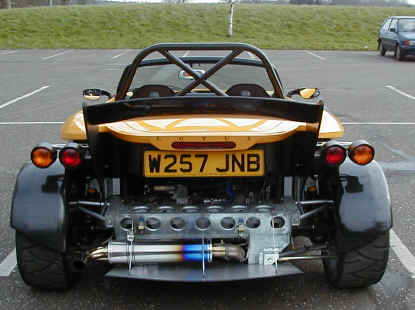
Rear view of the custom cage which is slightly taller than standard
Carbon fibre rear wing supports
Made by Reverie Ltd, these replace the standard aluminium wing supports which weigh 2 kg each ! The carbon fibre wing supports are made in a carbon sandwich construction with lightweight core having the bottom section in solid carbon for higher strength than the standard item in this area (essential as it connects to the rear roll cage struts). The lighting clusters are relocated upwards about 15mm on my version to increase clearance above the mudguards to prevent contact. The lightweight items weigh 0.55kg each.

A view of the lightweight carbon wing support
Carbon fibre mudguards
Only a handful of cars were provided with carbon fibre mudguards as standard - the rest of us will have to buy the Lotus aftermarket versions to replace the heavier GRP items. The CF mudguards do have the advantage of not needing the rather ugly mark 3 rear mudguard additional support bracket and they also seem less prone to hitting the lamp clusters. One drawback is that they do not have the soft anti resonance coating on the underside so any stones make a loud noise. A set of carbon fibre mudguards give a total weight saving of about 5kg.
Lotus Part Numbers:
A340B0037 (Front LH) Part List Price (plus VAT) 253ukp
A340B0038 (Front RH) Part List Price (plus VAT) 253ukp
A340B0039 (Rear LH) Part List Price (plus VAT) 402ukp
A340B0040 (Rear RH) Part List Price (plus VAT) 402ukp
The standard mark 1 fixing brackets are used for the rears.
Carbon fibre seats
Whilst the standard seats look very pretty in carbon look leather and alcantara, Lotus did develop a much lighter version for fitment to their track car. This seat is a carbon shell with thin strips of high density foam stuck on in strategic locations to aid comfort. One advantage for taller drivers is that because of the reduced thickness the seating position is a couple of inches lower giving a better view of the instruments and a lower head position behind the windscreen. For a modest cost many owners will wish to increase safety by fitting the optional 5 point harness kit which comprises a replacement buckle and additional crotch strap. Whilst not as comfortable for road use as the standard seats the carbon seats are comfortable enough for track work. The standard seats each weigh 8.5kg and the carbon seats weigh 2.0 kg giving a useful weight saving of 13kg for a pair of seats
Lotus Part Numbers :
A340U6010S Carbon Race Seat - Part List Price (plus VAT) 599ukp
A340U6005S 5 point harness kit (one seat) - Part List Price (plus VAT) 99ukp
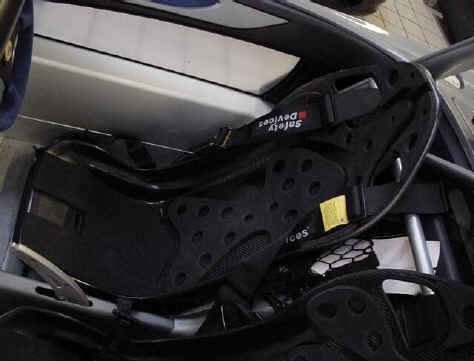
A view of the carbon fibre seats
Carbon fibre steering wheel
As standard the 340R is fitted with a normal Elise steering wheel which is surprisingly heavy at 1.7kg. A lighter weight quick release item is available from Lotus but this is smaller and lacks the normal offset making it difficult for tall drivers to see the dials, it also does not have a lock so it can easily be removed by a souvenir hunter. I went for a hollow carbon fibre ultra lightweight wheel from Reverie Ltd - including fitting kit and collapsible boss it saves 1.0kg. The stiffness of the wheel gives increased feedback of the state of grip beneath the tyres which is an added bonus for track users. My version of the wheel has additional offset to exactly replicate the size and position of the standard wheel which I find to be perfect. A Lotus Motorsport Momo horn push finishes the wheel off nicely.
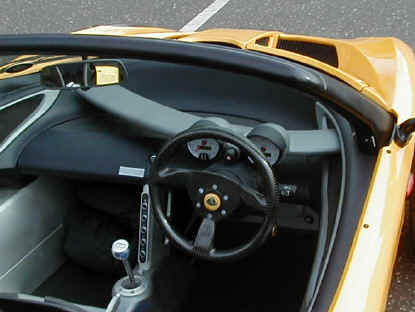
A View of the Reverie CF steering wheel (note short shift gear lever)
Carbon Race Air Box
The standard 340R airbox has a steel backplate and is constructed from GRP with a couple of layers of carbon on the outside for cosmetic effect - on a standard car a lighter weight version cannot be used because of the weight of the air inlet drive by restrictor valve. On track cars or those who have removed the valve, lighter items can be used and are available from Lotus. The alloy back plate saves 0.5kg and the Carbon race airbox saves 0.5kg. Most enthusiasts will also wish to run with only one filter fitted which should be the one located on the airbox.
Lotus Part Numbers :
A340E6015S Carbon Race Airbox - Part List Price (plus VAT) 299ukp
A340E6003S Alloy air box backplate - Part List Price (plus VAT) 25ukp
Alloy race fuel tank
This is a smaller lighter fuel tank.
Capacity is 6 gal (27 litre) compared with 8 gal (36 litre) for the standard steel tank.
Weight is 3.45kg compared with 10 kg for the standard steel tank.
Particularly suitable for track use this tank saves 15.5kg over the standard tank when full (particularly relevant for kerb weight). It's capacity is adequate for all but the most excessively long track sessions and works very well when using Jerrycans containing 18 litres of fuel (refill as soon as you see the last LCD bar in the fuel gauge). However it's lower capacity does mean increased frequency of refuelling making it not very suitable for those using the car without support vehicle.
All super unleaded (97RON) fuel users should be aware that the sender unit requires a special specification Locktite 5205 liquid gasket to be used instead of the normal Hylomar liquid gasket which is prone to softening when exposed to this grade of fuel.
Lotus Part Number : A340L0015 Part List Price (plus VAT) 299ukp
Race Battery
This is a smaller lighter battery ( Red Top 20 made by DMS technologies) also used on racing Elise's. The race battery weighs 2.7kg against the standard battery's 11kg.
An additional benefit of the race battery's smaller size is the fact that it can be removed via the front access panel should this be required. The standard battery requires the body to be taken off making this an expensive job.
Whilst the race battery's electrical capacity is less than the standard battery, in normal practice this proves not to be a problem. However it is recommended that for vehicles subject to intermittent use (ie most 340R's) a battery trickle charger should be used. A trickle charge socket is fitted to all 340R's for this purpose. (Click here for trickle charger information)
Lotus Part Number : A111M6078S Part List Price (plus VAT) 123ukp
Lightweight alternator
The standard alternator on the 340R is the same item fitted to all Rover K Series engines and is quite a heavy item. Owners who use their cars mainly on track at high engine RPM, rarely use their cars with lights on on heavy traffic and who do not use the heated clothing sockets, may wish to fit a smaller lighter race type alternator (mine was supplied by QED).
Many enthusiasts have found that under extreme use the standard alternator does suffer from reliability problems - hardly surprising when you consider that the same configuration is used on a 1.4 Rover Metro as that on a 190 bhp 340R which revs to 8000rpm and has a rear engine compartment which is hotter than hell.
The problem of high alternator speed can be remedied by the fitment of a larger size alternator pulley (again available from QED) and the problem of heat can be mitigated by the fitment of a flexible duct connected to the right hand air inlet pod which discharges air onto the top of the alternator (this is has become common practice on Exiges too). A word of warning though - some companies (QED included) sell a lightweight speed reduction crankshaft pulley which would offer a further speed and weight reduction, however owners should be aware that the standard crankshaft pulley (which is a big heavy item and is fitted with a redundant power steering/air conditioning pulley) has an internal rubber damping section to counteract imbalances and harmonics which develop at high engine speeds. Owners who fit an undamped pulley on the standard crankshaft run the risk of severe engine damage and destruction of the standard specification gear type oil pump which sits on the other end of the crankshaft. Anecdotal evidence suggests that out of tolerance Rover manufactured camshaft pulleys may also contribute to the problem. Undamped pulleys can only be used without risk by those with custom built balanced crankshafts and sintered metal high specification oil pumps.
The QED supplied Brise lightweight race alternator (compete with lightweight speed reduction pulley, fixing bracket kit and belt) weighs 3.35kg compared with 5.9kg for the standard arrangement.
Lightweight brake discs
In the quest to save weight the standard full cast iron discs can be improved upon. Reduction of weight on this part of the car is reduction of unsprung weight which should allow the suspension components to operate more efficiently and improve handling.
The original metal matrix compound (aluminium) brakes fitted to the early Elise were exceptionally light but are not suitable for vigorous track use as they cannot cope with the increased heat, hence Lotus fitted full cast iron discs to their more performance oriented variants - although the fact that the manufacturer of these parts went out of business means that they are no longer available.
The solution on many race cars is to use a bell and rotor construction comprising an aluminium inner bell bolted to a conventional cast iron rotor which forms the contact area for the pads. These have the additional benefit of improved conduction of heat away from the discs because the central aluminium section is a much better conductor of heat than cast iron.
I went for a set of Elise specific discs from Eliseparts.com which are cross drilled and have deglazing grooves on the surface. The recommended pads for track use with these are Pagid RS14 (identical to Lotus Motorsport Pads).
Whilst the weight saving of the discs was found to be slightly disappointing (a set of 4 save 2.2kg), this combination has been a fantastic improvement. Pedal feel is very hard and stopping ability is greatly increased over the standard configuration, which is already fantastic compared with most cars. Clumsy application of the brakes at speed does need to be avoided though as it is quite easy to lock the wheels in the dry at 100mph if you press them hard enough.
Be warned though when the brakes are cold (and especially when new) these pads can squeal like an old bus and so can be a nuisance on the road at slow speed around town.
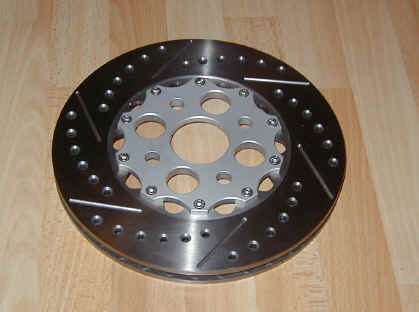
Eliseparts.com's Bell and Rotor brake disc
The Goodridge braided steel brake hose set (which replaces the standard all rubber hoses which have a tendency to flex under heavy breaking ) also contribute to the harder pedal feel and give more positive braking control and is recommended for fitment to enthusiasts cars.
Lotus Part Number : A340J6000S Part List Price (plus VAT) 49ukp
Whilst on the topic of brakes, owners should note that for track use (or use on mountain passes), the standard brake fluid should be replaced with Castrol RS fliud. This is an official Lotus upgrade which can also be bought via your dealer. Unlike the standard fluid, this never boils or gives brake fade, it's only drawback being the need to replace the fluid every year as it will absorb moisture
Lotus Part Number : A340J6001S Castrol racing brake fluid (1 liter) Part List Price (plus VAT) 35ukp
Track Pack Springs
When reducing the car's weight a natural result is that the ride height will increase as the springs become less compressed.
This requires the ride heights to be re adjusted once all the weight saving has been achieved.
Lotus developed the 'Track pack springs' for their lightweight 340R track car.
According to Lotus these:
"have the
standard 340R spring rates but with more progression in the end coils to
take up full droop spring platform displacement. This is necessary because
the track car weighs 571kg dry and would have 4mm and 12mm displacement
between springs and platforms when at full droop with platform
heights adjusted to ride heights of 100 &110mm"
Whilst my own car was not as light as their totally stripped out single seater car, I did find that on my car the standard springs were too short when the ride height was adjusted and the car was jacked up. This meant that the track pack springs were essential.
Lotus Part Number : A340X0002S Track Spring Kit Part List Price (plus VAT) 139ukp
Conclusion
The kerb weight of a standard car is 701kg
The kerb weight of my lightened car is 621kg - so I have been able to reduce the weight by a total of 80 kg.
My car is fitted with,190upgrade and free flow exhaust (195PS) and Boost Tube (+6.5PS), giving an estimated power of 201.5PS.
According to Lotus figures the difference between dry and wet weight for the 340R is 40kg. In the case of my car this is reduced to 31kg because of the smaller fuel tank capacity, therefore the projected dry weight of my car is 589.98kg.
Thus the dry power to weight ratio is : 341.5 PS/tonne
End result : the car now achieves the power to weight ratio which the designers originally intended!
Driving Impressions
The improved power to weight ratio manifests itself in a much more aggressive acceleration through the gears (which now feel very short). Hard depression of the throttle makes passengers heads hit the seat headrest and the car feels much more responsive to throttle pressure. Top speed appears largely unaffected.
The lighter weight makes the car feel even more stable from a handling point of view, and the balance of the car feels perfect. From a drivers perspective it makes the standard cars feel more bulky and less agile - although the ability to translate this into higher cornering speeds depends as always on driver competence and aggression.

Testing the car at Donnington
My opinion is that the car has been much improved for track use and can be summed up as - "like a 340R only more so."
Some comments from other owners who drove the car at Spa in May 2002 :
Ian Jamie :
"It feels like a totally different car to mine, much more like a race car"
David Harvey :
"My 340R has 220 horsepower but the lightweight car feels just as quick"
More Technical Information
To see a spreadsheet listing my complete weight saving measures click here.
Click here to see names, addresses and other contact details for the parts.
To support this site, please click on our sponsors link below :
Air Conditioning UK- by Celsius Air Conditioning Ltd
Click below to jump to pistonheads news
